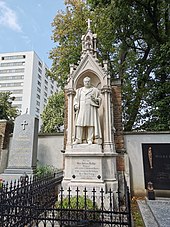Andreas Halbig
Andreas Halbig (born April 24, 1807 in Donnersdorf ; † May 3, 1869 in Penzing , today Vienna ) was a German sculptor and the brother of Johann von Halbig .
He learned from Konrad Eberhard in Munich, worked for many Bavarian churches and took care of the restoration of the Marienkapelle in Würzburg. In his Franconian homeland he probably also fitted the Bartholomäus Church in Oberspiesheim with the classicist side altars. In 1856 he moved to Vienna. The stone, polychromed high altar of the Vienna Augustinian Church is considered to be his main work . He worked on this high altar made of sandstone in neo-Gothic style from 1857 to 1869. It was originally intended for the Vienna Votive Church . Heinrich von Ferstel , the builder of the Votive Church, refused the altar because it would have prevented the ambulatory from looking through, so the altar was installed in the Augustinian Church in 1873.
His brother Johann Halbig placed his grave monument for him. A street in Donnersdorf was named after him.
literature
- Halbig, Andreas. In: Austrian Biographical Lexicon 1815–1950 (ÖBL). Volume 2, Verlag der Österreichischen Akademie der Wissenschaften, Vienna 1959, p. 159.
- Karl von Lützow (ed.): Nekrolog . In: Zeitschrift für bildende Kunst , fourth volume, Leipzig 1869, p. 219
Web links
Individual evidence
- ↑ Tour through the church - Augustinian Church Vienna. In: augustinerkirche.augustiner.at. Retrieved December 15, 2019 .
- ^ Propsteipfarramt Votivkirche (Ed.): Votivkirche in Wien (church leader); Kunstverlag Hofstetter, Ried im Innkreis 1990
- ^ Hyacinth Holland: Halbig, Johann . In: Allgemeine Deutsche Biographie (ADB). Volume 49, Duncker & Humblot, Leipzig 1904, p. 784.
| personal data | |
|---|---|
| SURNAME | Halbig, Andreas |
| BRIEF DESCRIPTION | German sculptor |
| DATE OF BIRTH | April 24, 1807 |
| PLACE OF BIRTH | Donnersdorf |
| DATE OF DEATH | May 3, 1869 |
| Place of death | Penzing , today Vienna |

